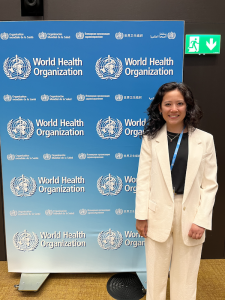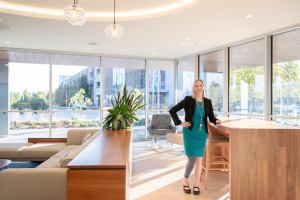Building technology to enhance human performance and overcome disability demands a multi-disciplinary approach. From health advocates to technologists, medical professionals to engineers, innovation is accelerated through collaboration.
I’m pleased to share the first episode of Superpowering the Human Body, a podcast I host that explores the intersection of science and technology for human augmentation.
My first guest is Brian Kolonick, formerly at Conversa Health and Cleveland Clinic, and now VP Strategy & Business Development at CIONIC. He shares his experiences on the importance of innovation as a team sport, as well as his optimism for advancing neurological technologies in the coming decade.
The full transcript is below, edited for readability.
Jeremiah: Hi, my name is Jeremiah Robison, Founder and CEO of CIONIC. We build bionic clothing to enhance human performance and overcome disability Welcome to our podcast Superpowering the Human Body where we explore the Science and Technology of human augmentation. Today on the show. I’m joined by Brian Kolonick our new head of strategy and business development at CIONIC. Welcome Brian happy to have you on the team and happy to have you join us today.
Brian: Hey Jeremiah, thanks for having me and thanks for having me today. How are you?
Jeremiah: Excellent. Now Brian you spent 10 years at the Cleveland Clinic heading up a very important initiative there called the Global Innovation Health Care Alliance. Tell us about the alliance and tell us about how organizations like the Cleveland Clinic are embracing and fostering innovation in healthcare.
Brian: Sure, happy to. So Cleveland Clinic, large academic Medical Center, well-respected here in the United States started really doing Innovation since they started but then got into doing more commercialization of their Innovation probably in the 2000s. And that proved to be successful, and as other hospitals were looking for additional revenue streams outside of just patient care. They were looking toward Innovation as being one of those sources and as they were looking at building those out. They saw it being expensive and a bit challenging for them. So it was kind of a buy versus build approach and we went out and we became more of a Consulting arm, but in a true partnership, it wasn’t a vendor-client relationship. We really shared ideas, found ideas and Innovation within their organization and then move those through to commercialization as we would our own technology. So really, a fantastic program and one in which you got to see every type of innovation from medical devices to Therapeutics to a lot of tech as well.
Jeremiah: My understanding is that a lot of these Innovations were coming out of the problems that the healthcare providers were seeing in their work and trying to solve those problems. Can tell me a little bit more about how that worked.
Brian: Absolutely. So when we say providers, that would be all caregivers — — so nurses and and surgeons and researchers anyone can have an idea or identify a problem. We had one that was in the Environmental Services and what they would say is they would go in and they would take down the patient separator blind and they said “everytime we touch this, we have to rewash it. But, this piece right here could be an antimicrobial sleeve that could come on and off.” And, that came from someone who was looking at it every day, and they drove down the cost of what they were doing for their linens [pause] They probably have to wash them a lot more now with COVID, but at the time it was a really wonderful, novel innovation. It really can come from anywhere and it’s really trying to create a culture of innovation, where identified unmet needs — be it clinical, administrative or otherwise — can be solved with some kind of thinking by those that are experiencing it each day.
Jeremiah: I think that’s a very profound and important statement of how the people who are seeing the problems everyday know some of the ways in which to solve them. Solving what’s really happening in their day-to-day jobs. Part of what I think about in terms of “how do we foster more innovation within the technology community?”, the community that I come out of, is helping them understand the challenge of the system as well as what is happening within the human body. We talk about human augmentation, well, you have to understand the body first. What are the ways in which our knowledge of what’s happening — both within the neurology and the physiology of the body — can be translated out into the world of technologists to help them come up to speed faster?
Brian: So that’s a great question. I think oftentimes, technologists, at least from my experience when I was at the Cleveland Clinic, when we looked at “outside in” — — meaning outside companies that were coming to the clinic to do a pilot or to be a customer, to help develop a research site, sometimes their iterations and their technology was so far down the road that they were addressing the wrong problem. So really getting connected and getting an idea of what the pain points are…what the processes are… what the patient’s journey looks like..being informed in that as you create Innovation, as you develop your solutions and your technologies. It’s a really important part of it; to couple the end user — — and this case the end-user being another clinician or a rehab Specialist or the patient; there’s a lot of end users. But understanding what that end user’s needs are and it’s a great process to go through and it usually proves to be the most successful.
Jeremiah: Well, you mentioned all of the different constituents who touch parts of that patient journey, and one of the things that has been really outstanding about technology innovations across a number of different spaces over the last decade has been the embracing of the whole problem. Not just solving one particular challenge within it, but really thinking about the whole journey of that user. When you talk about neurological injury, neuromuscular disease, there’s a lot going on in the patient. How has innovation embraced that whole person and their whole journey to create a better solution overall?
Brian: I think you and I spoke about this early on. I really anticipate the next decade as being the decade of the brain.The last year when we talked about medical Innovation, a lot of it was oncology. Ten years before that., we were making large advancements beyond the statins and we looked at cardiology. But now I think we’re starting to look at the neurological side. Some of those investments have been very invasive, whether it be deep brain stimulation or even sensors that are implanted. Some have been developed without thinking about the entire patient’s journey in mind. So I think now this will be a much more thoughtful focus. What I’m experiencing with the CIONIC and in speaking with these stakeholders — more thoughtful approach to the patient and to the the rehab specialist, but also I think the most unforgotten person in this that benefits well is the caregivers at home. Improving a patient’s life in mobility or a neurological issue, releases an unspoken buren that family members have that are taking care of these patients, and it allows them to get back to work or to be able to do some of the things that they maybe weren’t able to do because they were doing caregiving. I think that’s an important piece too and I think that there is a focus on it from neurologists, clinicians moving forward, as this decade being one of improvements of those neurological diseases.
Jeremiah: It reminds me of a conversation I was having with a neurologist just last week. He says when he talks to his Parkinson’s patients he always sits their caregiver half a beat behind so that he can check to see whether the answers that are being given by the patient are confirmed by the caregiver ,who may have a different perspective on it. It speaks to what I think about in terms of not just the independence of living with one of these conditions, but also, your own pride and your own sense of self within it . Can you talk a little bit about what you’ve seen in those patient populations and what has worked to help give them that sense of self that is so important to overall health?
Brian: I could be any number of things. When I was working at National Stroke Association, there were so many different types of deficits that people had with strokes, and they were all different. Meaning that each individual situation was different. Some had what we called locked-in syndrome — where they couldn’t speak — their aphasia was bad, but they understood everything going on around them. You get a deep appreciation for that. The thing is, what’s going on between your two ears and your brain is so much more powerful — your emotions, your thoughts — all of those things, and then tying into what potential deficits you’re having or disabilities you’re having that are associated with it. What I found to be really unique with neurological disorders and neurological diseases and it’s probably one of the more important areas — is that we need to treat the whole patient. Whether it be mobility, but also, their emotions… how are they feeling? Are they interpreting everything that you’re sharing? If they’re nodding does that mean they’re retaining it in an actionable way? When I would work with the neurological patients throughout my career this was always probably my favorite area because it was very clear that the caregivers in that space were very kind and very thoughtful to treat the whole patient.
Jeremiah: That’s absolutely been our experience as well. That’s all for this episode of Superpowering the Human Body. Thank you for listening and thank you Brian for joining me today and sharing your perspective on bringing new solutions to overcome neurological injury and disease
Brian: Great talking to you, Jeremiah. Thank you.
Jeremiah: You can subscribe to our podcast on SoundCloud, or on YouTube or visit us at cionic.com. Until next time.





